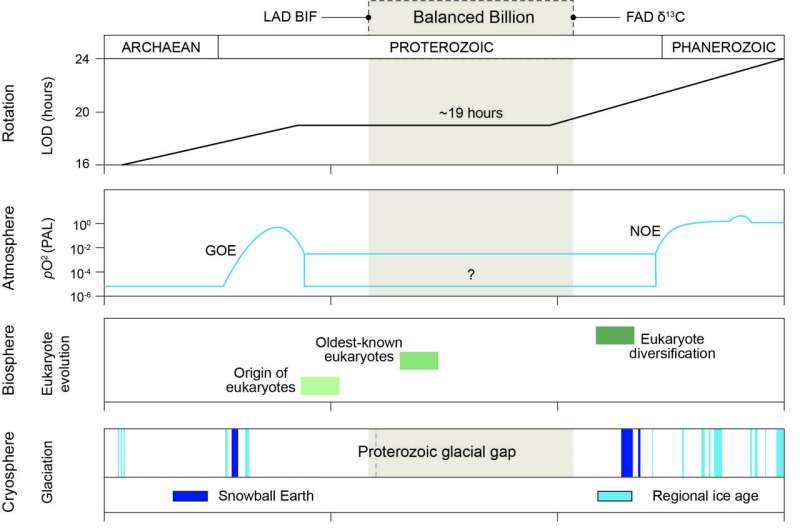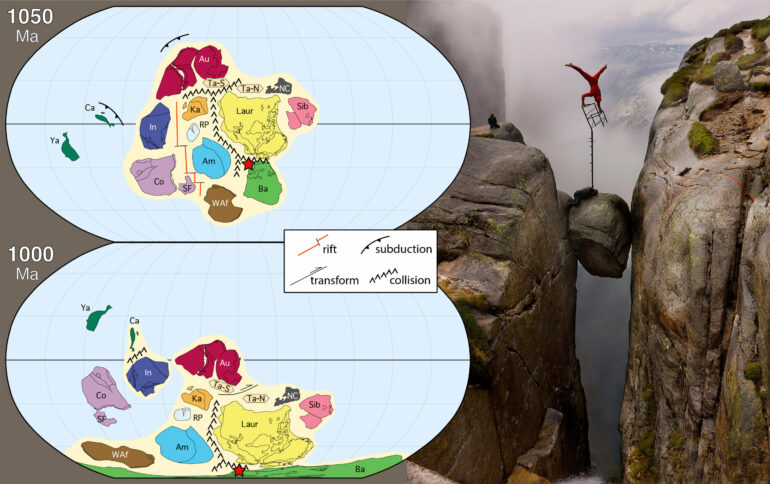Branding seems like it’s everywhere today. And it’s not just the swoosh on your Nikes or the bitten apple icon on your laptop anymore. Social media influencers craft their personal brands. But is there even branding in science? You bet there is.
There’s a billion-year-long stretch of Earth’s 4.56-billion-year-long history that has for decades been referred to by geologists (somewhat reluctantly) as the “Boring Billion.” But the name has never really taken, and recently I (Ross Mitchell, Chinese Academy of Sciences, and author of “The Next Supercontinent”) and David Evans (Yale University) have suggested that it’s time for a change.
The concept of a so-called Boring Billion—from roughly 1.8 to 0.8 billion years ago—was first inspired several decades ago by the apparent absence of any significant perturbations to Earth’s carbon cycle and was linked to the relatively dull interval in the long-term rise of atmospheric oxygenation.
In our new paper in the journal GSA Today Evans and I start by showing that the data behind the concept of the Boring Billion have not only stood the test of time, but the apparent idiosyncrasies of that eon extend beyond Earth’s surface environment, into Earth’s deep inner workings as well.
Our paper starts by pointing out other aspects of Earth’s surface environment that were also static during that time. First, there is a complete lack of evidence for glaciation. Glaciation has come and gone repeatedly through Earth’s history, with this one exceptional, very long, warm period that some might find climatically boring.
Second, the origin of complex life (called eukaryotes) occurred before the ice-free interval and its diversification into animal life as we know it waited until after it to take place. A billion years is quite a long time to wait—especially for impatient evolution.

Records from all of Earth’s layers (from top to bottom) exhibit important idiosyncrasies during the Balanced Billion (light brown band). © Ross Mitchell
And we didn’t stop there. We dug deeper (literally) into Earth’s inner layers. Citing recent advances from plate tectonics and Earth’s crust, mantle, and even the core, we find that essentially the whole Earth was acting peculiar during that time.
But the old term the Boring Billion—despite its apparent validity in the Earth system and the appeal of its alliteration—has soured in recent years. Scientific articles and the popular press have repeatedly reported strawman arguments when any new discovery from that interval is at odds with the subjective concept of dullness.
Picking up on new clues from convection in the massive mantle, and the moon and the sun’s tidal forces controlling Earth’s length of day, Evans and I introduce a new concept of “balance” and suggest rebranding the time period to the “Balanced Billion.”
Just as one might marvel at a tight-rope walker, we suggest that discovering what overarching processes kept the Earth from swinging between extremes is the real question to be asking. For an entire planetary system to remain suspended in balance, a series of interrelated feedbacks between the solid Earth, its ocean, and its atmosphere, must act in delicate synchrony.
Nick Roberts of the British Geological Survey, who wasn’t involved in the study, says, “The Boring Billion needed to go. I never bothered to think of an alternative, so I’m glad someone has.” Roberts also thinks the new name will serve the science well. He asserts, “How balanced was it? Well it’s a good cue to do more research and find out….”
We hope that the concept of Balance will help us better understand the long-delayed fuse in the rise of animals. We also bring to attention that unlocking the secrets to the Balanced Billion may help society devise climate change solutions that mimic a time when Earth was more measured in its global change.
This story is part of Science X Dialog, where researchers can report findings from their published research articles. Visit this page for information about ScienceX Dialog and how to participate.
More information:
Ross Mitchell and David Evans, The Balanced Billion, GSA Today (2024)
Dr Ross Mitchell is a professor at the Institute of Geology and Geophysics, Chinese Academy of Sciences (IGGCAS) in Beijing. He holds a PhD in geology and geophysics from Yale University and served as a postdoctoral fellow at Caltech. His research aims to discover the governing dynamics of the supercontinent cycle – the repeated assembly and breakup of Earth’s continents by plate tectonics. His research has been published in Nature and Nature Geoscience and covered by outlets including the New York Times, Scientific American, NPR Science Friday, and Science. His book, The Next Supercontinent, published this year by the University of Chicago Press, uses Earth’s distant past to predict its potential future.
Citation:
Earth’s billion-year balancing act (2024, February 5)



